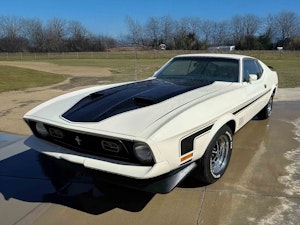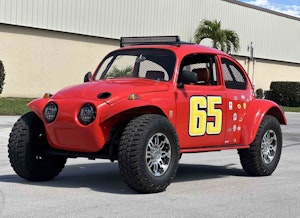Media | Articles
MG Midget Buyers Guide: TC, TD, TF
Why you want one: You can drive like Stirling Moss and still not get a speeding ticket
Years built: 1945-55
Production: MG TC: 10,000; MG TD: 29,664; TF: 9,600
Engine: 1,250cc/1,466cc OHV 4-cylinder
Horsepower: 54.5-63 hp at 5,200 rpm
Top speed: 78-86 mph
The MG TC burbled into the American consciousness in 1945, with returning American servicemen, but Midgets were already icons in England. They were part of a tradition of sports cars built like WWI biplane fighters: noisy, slow, unreliable, with arcane construction involving wood and leather and metal, lovingly combined into an elegant (if impractical) package.
The TC was the third T-Series, following the TA of 1936 and the short-lived TB of 1939. The TC body was four inches wider and it was faster than the TA and TB, but it had the same fold-down windshield, flowing wings, 19-inch wire wheels, slab gas tank and rear-mounted spare. It was also only available in RHD, not much of a problem in the U.S. with a narrow, slow car whose top would be down 99 percent of the time. The XPAG engine displaced 1,250 and could push the car to about 75 mph, which was more than enough for the cart-spring suspension and drum brakes.
MG cranked out 81 new TCs in 1945, when everything was in short supply, then 1,600 in 1946 and 3,000 in 1948. In all 10,000 were made before the model was discontinued in 1949. South Africa and Australia bought quite a few, but the big surprise was America, where 2,000 were sold and about 1,500 others imported privately. There was even a North American model, still RHD, but with turn signal flashers and vertical chrome bumpers.
The American market demanded an upgrade, and designers Syd Enever and Alec Hounslow stripped a 4-seater Y-type tourer (which had been a flop) and shortened the chassis five inches to come up with the MG TD Midget in only two weeks in 1949. It was launched just as the British pound was devalued, and, thanks to rack-and-pinion steering, LHD was offered at last, along with smaller, 15-inch steel disc wheels — no wire wheels were offered. The car was wider and 200 pounds heavier than the TC, partly because of the bumpers necessary to handle American parking skills. The 54 hp XPAG motor worked hard, but the car was slower than the TC.
Marketplace
Buy and sell classics with confidence
The TD was an unqualified success and 29,664 were sold in four years — three times TC production. Almost all of those — 24,388 — went to the U.S.
There was also a TD2, with a few detail differences, but don’t confuse these with the collectible TD MK II, made in very small numbers for club racers. Performance woes were addressed and the TD MK2 gained 5.5 percent more horsepower, thanks to increased compression ratio and bigger valves. Additional friction dampers, MK II badges on the hood (and a bulge over the carburetors) and chrome grill bars instead of a color to match the interior also identify a MK 2. MK2s were produced alongside the standard TD but made up only 3.5 percent of production with between 1,000 and 1,710 being sold, depending on reports. Top speed for the MK2 was quoted as 83 mph, up 5 mph from the standard car. For competition, several further stages of tune were available, including super-charging.
The MG TF 1250 Midget was launched at the Earls Court Motor Show in 1953 to a storm of criticism. These days it looks like an elegant update. It’s three inches lower than the TD, with a sloping grille and faired-in headlights, but the Austin-Healey 100 and Triumph TR2 appeared at the same show and their full-width bodywork and 100 mph top speed made the 80 mph TF look antiquated.
The TF was an uneasy compromise, attempting to modernize a truly ancient design. The dash was redesigned with central octagon gauges, good for right- or left-hand drive, though surprisingly there was still no gas gauge. Wire wheels were offered once more, but engine access was severely hindered by the hood side panels being fixed. A need for more power led to the XPEG engine, bored out to 1,466 cc and those cars have 1500 badges on the hood sides.
In all, 9,600 TFs were sold, with 3,400 being the 1500 model, before the streamlined MGA finally arrived in late 1955. Today, the TF has overcome its early criticism to be considered the most desirable of these three T-Series models, which is reflected in prices. Figure on spending $20,000-$50,000 for a good car that needs nothing obvious.
MG T-Series cars were assembled individually and many have just vibrated loose over the years. As the wood wears or rots, the whole thing is constantly in motion when the car is running, with squeaks and rattles to beat the band. If you think the wood needs to be replaced, it does. Take a lot of photos if you do a frame-off, number everything and sketch how it all fits together, or you won’t be able to make any sense of the pile of bits on your garage floor. If you are a skilled woodworker, you can probably rebuild a T-series MG better than the factory. Wood kits have been made periodically and are worth sourcing.
Rust isn’t as much of an issue as rot. The bodies are composed of ash wood frames with metal panel tacked on and wet weather immediately begins the process of separating the two. Morgan considers that wood framing will need to be replaced every seven years, if the car sits out. MG T’s aren’t exactly waterproof, with poor-sealing tops and side curtains, so a California or Southern car is desirable. Cars from less gentle climates can be considered, but only with excellent provenance or a recent, documented restoration.
You must be certain they were garaged. With little suspension travel, MG T’s take a beating on bad roads and this will show up when panel fit becomes loose. Doors that have dropped are the first sign of structural problems. Rust can occur in doors, at the bottom of the cowl and in the rear behind the gas tank and along the skirt. Front fenders may rust around the supports.
A good original leather interior would be a prize, but by now most have been retrimmed. Remember leather must be fed regularly with lanolin treatments or it will shrink and stitching will pull out. Older leather upholstery can sometimes be quite thick, so if it has become hard, it can be saved.
NOS gauges can be found and there are remanufactured units, with the only really difficult one being the twin oil pressure and water temperature gauge, one of which always quits first. The dashboard is wood but it was always covered in vinyl to match the interior. Carpet should not be on TCs and there is very limited carpet edging on the later cars. The wiper motor does not project above the screen on TC and TDs — that means it’s upside down. TCs and TDs did not come with full tonneau covers, though they were offered on the TF. All tops were vinyl, not canvas, and no T-Series MGs came with a black interior.
The XPAG engine is a robust and useful performer and should be relatively quiet. The only weak point is the crankshaft, which is fragile and hard to get these days. The clutch is light and the gearshift should be quick and positive. Beware of excessive noise in first — which will always whine due to lack of synchromesh — and second gear, worn synchros on second and third, and jumping out of gear on deceleration. If the car hasn’t been driven and maintained regularly, make sure wheelbearings and all the powertrain and suspension grease points are serviced before driving far. T-Series cars were built with a view to service work being done on a weekly basis.
As always, check MG clubs to find cars for sale and take an expert with you. Richard Monk’s “The MG Collection,” published by Patrick Stephens Limited at $80, is quite useful. Helpful clubs include the MG Owners’ Club www.mgcars.org.uk and the Worldwide MG Car Clubs list, www.mgclub.org.










